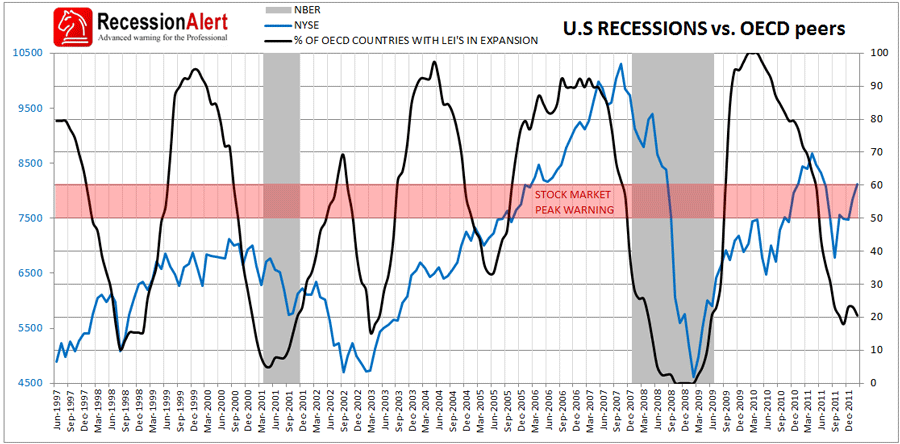With many parts of the Euro-zone entering or already in recession, and the OECD recently putting Australia, Germany and Italy into recession, one has to wonder if the feeble U.S recovery can skirt a global recession. Many mainstream pundits have been pointing to countries around the globe slipping into recession as a reason why a U.S recession in the near future is a done deal. But this is not necessarily the case. The chart below shows which percentage of the 39 OECD countries across the world have their Leading Economic Indicators (LEI’s) in expansion. We used the 12-month rate of change of the amplitude adjusted LEI’s to determine expansion or recession.
It is clear that there can be some severe stress in the 39 OECD countries without the US falling into a NBER classified recession. In July 1998, only 10% of the OECD country group was in “expansion”. There was a sympathy sell-off from the U.S stock market, but no U.S recession. In March 2003, just 15% of the OECD group was in expansion – again, a US stock market sympathy sell-off but no official U.S recession. In June 2005, just 32% of the OECD group was in expansion – there was a tiny US stock market sell-off but no recession.
With less than 50% of countries in expansion, one could argue this would be a good definition of a “global recession.” In fact it would appear when the index of percentage of OECD countries in expansion falls below the 50-60% mark it is a good warning for a U.S stock market peak, but there is no threshold above 10% which guarantees U.S recession.
You can see that from June 2011 the index dropped below the red warning zone and a stock market correction ensued in sympathy. In October 2011 the index bottomed with just 18% of OECD countries in expansion (according to the 12-month growth rates of their OECD LEI’s) The stock market bottomed slightly before this.
We only went back to June 1996 as this is the farthest back we could go for which we have OECD LEI data for all 39 countries, but we plan to repeat this research going back 3 or 4 more business cycles with a smaller set of OECD countries to see if the theories hold, and publish the research for our subscribers.
The next few months behavior of this index will be interesting to watch but we can make one observation about the current levels and that is it is not indicative of a pending stock market correction or peak. If anything, if the index starts pointing upwards, this will signal continued U.S stock market gains.


Really interesting analysis, thanks.
One observation: in 1998 and again in the mid-2000s, the US economy was being artificially stimulated by bubbles (stocks in 1998 and housing in the 2000s). This could account for the US resilience; if this is the case, we can’t depend on that resilience in the absence of a bubble.
Perhaps your followup piece will shed some light on whether this is an issue… looking forward to it.
Interesting approach. This leads to the question I’ve had for a few years: is there a relationship between economies that can be used to signal the likelihood of recession?
The one we hear about today is China towing the rest of the world economy. The other one that has been around for quite a while is the US dragging the rest of the world up or down. Are these really accurate statements and, if so, what is the lag or lead time in the relationship?
Also, and this is a bit more speculative, economies that would seem to be unrelated may have a linkage with varying lags. However, the ones I have heard of–ie, Japan as locomotive with Denmark, Philippines, Singapore, Sweden, and Switzerland; US as locomotive with Britain, Canada, and South Africa–seem like they could have a concrete relationship but it may be a statistical aberration. It would be interesting to know if the posited relationship is valid and, if so, if it provided an exploitable tool for gauging the leads and lags between the respective economies. One potential issue here is that any historical relationship may well not be forever stable. A change in this historical relationship, if it does exist, may be highly disruptive and disorienting to markets. I wonder how China and the EU would fit in today?
As long as we’re on the subject, you mention that the OECD data on the graph is the 12 month ROC of the amplitude adjusted LEIs–is that the same as normalized? Is there any relationship between the 12 month ROC of these LEIs and the ROC or other metric of the market itself? It would be useful to find some metric of the market’s behavior or sectors of it that had a relationship to the LEIs and provides a way of anticipating future LEIs–kind of like traditional Dow Theory use of the broad index and the transportation index. However, a methodological problem with this might be falling into a circular argument where each source of data was treated as functioning simultaneously as both a cause and effect. This seems to go against common sense a bit, unless what we have is some sort of feedback system with input and output linked by a feedback loop–that might just be the market mechanism. I’m not aware of a statistical test for causality instead of correlations but if there is one, here would be the place to use it.
I look forward to your research; it’s always a good read. Have a nice day.
The DJII hit 13,390 on Tuesday, the highest point since 2007, it would seem ripe for a “sympathy” correction even though recession may not be on the immediate horizon. Look forward to your followup.